Adaptive Transcutaneous Power Transfer to Implantable Devices: A State of the Art Review
Abstract
:1. Introduction
1.1. Wireless Implantable Devices
1.2. Environmental Variations
1.3. Review Organization
2. Background
2.1. Wireless System Architecture
2.2. Field Regions
2.3. Tissue Properties
2.4. Operating Frequency
2.5. Transcutaneous Antennas
2.6. Power Gain and Efficiency
2.7. Impedance Matching
2.8. Impedance and Material Properties
2.9. Resonance
2.10. Quality Factor
3. Components of Adaptive Transcutaneous Systems
3.1. Performance Metric
3.2. Tunable Components
3.3. Sensing and Feedback
4. Implementations of Adaptive Transcutaneous Systems
4.1. Input Power Adjustment
4.2. Adaptive Antennas
4.3. Frequency Tuning
4.4. Impedance Tuning
5. Summary and Future Directions
Conflicts of Interest
Abbreviations
| ICD | Implantable cardioverter/defibrillator |
| VAD | Ventricular assist device |
| EM | Electromagnetic |
| FCC | Federal Communications Commission |
| SAR | Specific absorption rate |
| MEMS | Microelectromechanical systems |
| CMOS | Complementary metal-oxide semiconductor |
| Tx | Transmitter (external) |
| Rx | Receiver (implanted) |
References
- Ratner, B.D.; Hoffman, A.S.; Schoen, F.J.; Lemons, J.E. Biomaterials Science: An Introduction to Materials in Medicine, 3rd ed.; Elsevier: Oxford, UK, 2013. [Google Scholar]
- Medtronic. Protecta DR Implantable Defibrillator. 2013. Available online: www.medtronic.com (accessed on 4 January 2016).
- St. Jude Medical. Current Plus ICD. 2013. Available online: www.sjm.com (accessed on 4 January 2016).
- Medtronic. Adapta Pacemaker. 2015. Available online: www.medtronic.com (accessed on 4 January 2016).
- Cyberonics. AspireSR. 2015. Available online: www.cyberonics.com (accessed on 4 January 2016).
- Medtronic. SynchroMed II Pump. 2014. Available online: www.medtronic.com (accessed on 4 January 2016).
- Cochlear Limited. Cochlear Implants. 2013. Available online: www.cochlear.com (accessed on 4 January 2016).
- MED-EL. Cochlear Implants. 2013. Available online: www.medel.com (accessed on 4 January 2016).
- Second Sight. The Argus II Retinal Prosthesis System. 2014. Available online: www.secondsight.com (accessed on 4 January 2016).
- Jonah, O.; Georgakopoulos, S.V.; Tentzeris, M.M. Orientation insensitive power transfer by magnetic resonance for mobile devices. In Proceedings of the IEEE Wireless Power Transfer Conference, Perugia, Italy, 15–16 May 2013; pp. 15–16.
- Medtronic. Enlite Sensor. 2015. Available online: www.medtronicdiabetes.com (accessed on 4 January 2016).
- Waters, B.H.; Smith, J.R.; Bonde, P. Innovative Free-Range Resonant Electrical Energy Delivery System (FREE-D System) for a Ventricular Assist Device Using Wireless Power. ASAIO J. 2014, 60, 31–37. [Google Scholar] [CrossRef] [PubMed]
- Si, P.; Hu, A.P.; Malpas, S.; Budgett, D. A Frequency Control Method for Regulating Wireless Power to Implantable Devices. IEEE Trans. Biomed. Circuits Syst. 2008, 2, 22–29. [Google Scholar] [CrossRef] [PubMed]
- Ng, D.C.; Bai, S.; Yang, J.; Tran, N.; Skafidas, E. Wireless technologies for closed-loop retinal prostheses. J. Neural Eng. 2009, 6, 065004. [Google Scholar] [CrossRef] [PubMed]
- Ho, J.S.; Yeh, A.J.; Neofytou, E.; Kim, S.; Tanabe, Y.; Patlolla, B.; Beygui, R.E.; Poon, A.S.Y. Wireless power transfer to deep-tissue microimplants. Proc. Natl. Acad. Sci. USA 2014, 111, 7974–7979. [Google Scholar] [CrossRef] [PubMed]
- Knecht, O.; Bosshard, R.; Kolar, J.W. High-Efficiency Transcutaneous Energy Transfer for Implantable Mechanical Heart Support Systems. IEEE Trans. Power Electron. 2015, 30, 6221–6236. [Google Scholar] [CrossRef]
- Amar, A.B.; Kouki, A.B.; Cao, H. Power Approaches for Implantable Medical Devices. Sensors 2015, 15, 28889–28914. [Google Scholar] [CrossRef] [PubMed]
- Rabaey, J.M.; Mark, M.; Chen, D.; Sutardja, C.; Chongxuan, T.; Gowda, S.; Wagner, M.; Werthimer, D. Powering and communicating with mm-size implants. In Proceedings of the Design, Automation and Test in Europe Conference and Exhibition, Grenoble, France, 14–18 March 2011; pp. 1–6.
- Denisov, A.; Yeatman, E. Ultrasonic vs. Inductive Power Delivery for Miniature Biomedical Implants. In Proceedings of the International Conference on Body Sensor Networks (BSN), Singapore, 7–9 June 2010; pp. 84–89.
- Roes, M.G.L.; Duarte, J.L.; Hendrix, M.A.M.; Lomonova, E.A. Acoustic Energy Transfer: A Review. IEEE Trans. Ind. Electron. 2013, 60, 242–248. [Google Scholar] [CrossRef]
- Brown, C.J.; Geers, A.; Herrmann, B.; Kirk, K.; Tomblin, J.B.; Waltzman, S. Cochlear Implants. Available online: www.asha.org/policy (accessed on 4 January 2016).
- Advanced Bionics. The Harmony Sound Processor. 2015. Available online: www.advancedbionics.com (accessed on 4 January 2016).
- Waters, B.H.; Sample, A.P.; Bonde, P.; Smith, J.R. Powering a Ventricular Assist Device (VAD) With the Free-Range Resonant Electrical Energy Delivery (FREE-D) System. IEEE Proc. 2012, 100, 138–149. [Google Scholar] [CrossRef]
- Ozeri, S.; Shmilovitz, D. Simultaneous backward data transmission and power harvesting in an ultrasonic transcutaneous energy transfer link employing acoustically dependent electric impedance modulation. Ultrasonics 2014, 54, 1929–1937. [Google Scholar] [CrossRef] [PubMed]
- Mazzilli, F.; Kilinc, E.G.; Dehollain, C. 3.2 mW ultrasonic LSK modulator for uplink communication in deep implanted medical devices. In Proceedings of the IEEE Biomedical Circuits and Systems Conference (BioCAS), Lausanne, Switzerland, 22–24 October 2014; pp. 636–639.
- Mazzilli, F.; Lafon, C.; Dehollain, C. A 10.5 cm ultrasound link for deep implanted medical devices. IEEE Trans. Biomed. Circuits Syst. 2014, 8, 738–750. [Google Scholar] [CrossRef] [PubMed]
- Poon, A.S.Y.; O’Driscoll, S.; Meng, T.H. Optimal frequency for wireless power transmission into dispersive tissue. IEEE Trans. Antennas Propag. 2010, 58, 1739–1750. [Google Scholar] [CrossRef]
- Zargham, M.; Gulak, P.G. Fully Integrated on-Chip Coil in 0.13 μm CMOS for Wireless Power Transfer Through Biological Media. IEEE Trans. Biomed. Circuits Syst. 2014, 9, 259–271. [Google Scholar] [CrossRef] [PubMed]
- Hui, S.Y.R.; Zhong, W.; Lee, C.K. A Critical Review of Recent Progress in Mid-Range Wireless Power Transfer. IEEE Trans. Power Electron. 2014, 29, 4500–4511. [Google Scholar] [CrossRef]
- Zhang, Y.; Zhao, Z.; Chen, K. Frequency-Splitting Analysis of Four-Coil Resonant Wireless Power Transfer. IEEE Trans. Ind. Appl. 2014, 50, 2436–2445. [Google Scholar] [CrossRef]
- Chan Wai Po, F.; De Foucauld, E.; David, J.B.; Delavaud, C.; Ciais, P. An Efficient Adaptive Antenna-Impedance Tuning Unit Designed for Wireless Pacemaker Telemetry. Available online: http://www.intechopen.com/books/modern-telemetry/an-efficient-adaptive-antenna-impedance-tuning-unit-designed-for-wireless-pacemaker-telemetry (accessed on 4 January 2016).
- Zargham, M.; Gulak, P.G. Maximum achievable efficiency in near-field coupled power-transfer systems. IEEE Trans. Biomed. Circuits Syst. 2012, 6, 228–245. [Google Scholar] [CrossRef] [PubMed]
- Li, H.; Li, J.; Wang, K.; Chen, W.; Yang, X. A Maximum Efficiency Point Tracking Control Scheme for Wireless Power Transfer Systems Using Magnetic Resonant Coupling. IEEE Trans. Power Electron. 2014, 30, 3998–4008. [Google Scholar] [CrossRef]
- Ahn, D.; Hong, S. Wireless Power Transmission With Self-Regulated Output Voltage for Biomedical Implant. IEEE Trans. Ind. Electron. 2014, 61, 2225–2235. [Google Scholar] [CrossRef]
- Park, H.; Kiani, M.; Lee, H.M.; Kim, J.; Block, J.; Gosselin, B.; Ghovanloo, M. A Wireless Magnetoresistive Sensing System for an Intraoral Tongue-Computer Interface. IEEE Trans. Biomed. Circuits Syst. 2012, 6, 571–585. [Google Scholar] [CrossRef] [PubMed]
- Wang, G.; Liu, W.; Sivaprakasam, M.; Kendir, G.A. Design and analysis of an adaptive transcutaneous power telemetry for biomedical implants. IEEE Trans. Circuits Syst. I Regul. Pap. 2005, 52, 2109–2117. [Google Scholar] [CrossRef]
- Kiani, M.; Ghovanloo, M. An RFID-Based Closed-Loop Wireless Power Transmission System for Biomedical Applications. IEEE Trans. Circuits Syst. II Express Br. 2010, 57, 260–264. [Google Scholar] [CrossRef] [PubMed]
- Christ, A.; Douglas, M.G.; Roman, J.M.; Cooper, E.B.; Sample, A.P.; Waters, B.H.; Smith, J.R.; Kuster, N. Evaluation of Wireless Resonant Power Transfer Systems With Human Electromagnetic Exposure Limits. IEEE Trans. Electromagn. Compat. 2013, 55, 265–274. [Google Scholar] [CrossRef]
- Si, P.; Hu, A.P.; Hsu, J.W.; Chiang, M.; Wang, Y.; Malpas, S.; Budgett, D. Wireless Power Supply for Implantable Biomedical Device Based on Primary Input Voltage Regulation. In Proceeding of the 2nd IEEE Conference on Industrial Electronics and Applications, Harbin, China, 23–25 May 2007; pp. 235–239.
- Van Schuylenbergh, K.; Puers, R. Self-tuning inductive powering for implantable telemetric monitoring systems. Sens. Actuators A Phys. 1996, 52, 1–7. [Google Scholar] [CrossRef]
- Ng, D.C.; Felic, G.; Skafidas, E.; Bai, S. Closed-loop inductive link for wireless powering of a high density electrode array retinal prosthesis. In Proceedings of the Electromagnetic Compatibility Symposium Adelaide, Adelaide, Australia, 16–18 September 2009; pp. 92–97.
- Kim, S.; Ho, J.S.; Poon, A.S.Y. Midfield Wireless Powering of Subwavelength Autonomous Devices. Phys. Rev. Lett. 2013, 110, 203905. [Google Scholar] [CrossRef] [PubMed]
- Wang, B.; Hu, A.P.; Budgett, D. Maintaining middle zero voltage switching operation of parallel-parallel tuned wireless power transfer system under bifurcation. IET Power Electron. 2014, 7, 78–84. [Google Scholar] [CrossRef]
- Schepps, J.L.; Foster, K.R. The UHF and microwave dielectric properties of normal and tumour tissues: Variation in dielectric properties with tissue water content. Phys. Med. Biol. 1980, 25, 1149–1159. [Google Scholar] [CrossRef] [PubMed]
- Schwan, H.P. Electrical properties of tissues and cell suspensions: Mechanisms and models. In Proceedings of the 16th Annual International Conference of the IEEE Engineering in Medicine and Biology Society, Baltimore, MD, USA, 3–6 November 1994; pp. A70–A71.
- Gabriel, C.; Gabriel, S.; Corthout, E. The dielectric properties of biological tissues: I. Literature survey. Phys. Med. Biol. 1996, 41, 2231–2249. [Google Scholar] [CrossRef] [PubMed]
- Gabriel, S.; Lau, R.W.; Gabriel, C. The dielectric properties of biological tissues: II. Measurements in the frequency range 10 Hz to 20 GHz. Phys. Med. Biol. 1996, 41, 2251–2269. [Google Scholar] [CrossRef] [PubMed]
- Peyman, A.; Rezazadeh, A.A.; Gabriel, C. Changes in the dielectric properties of rat tissue as a function of age at microwave frequencies. Phys. Med. Biol. 2001, 46, 1617–1629. [Google Scholar] [CrossRef] [PubMed]
- Christ, A.; Klingenbock, A.; Samaras, T.; Goiceanu, C.; Kuster, N. The dependence of electromagnetic far-field absorption on body tissue composition in the frequency range from 300 MHz to 6 GHz. IEEE Trans. Microw. Theory Tech. 2006, 54, 2188–2195. [Google Scholar] [CrossRef]
- Kanehisa, H.; Miyatani, M.; Azuma, K.; Kuno, S.; Fukunaga, T. Influences of age and sex on abdominal muscle and subcutaneous fat thickness. Eur. J. Appl. Physiol. 2004, 91, 534–537. [Google Scholar] [CrossRef] [PubMed]
- Peyman, A.; Gabriel, C.; Grant, E.H.; Vermeeren, G.; Martens, L. Variation of the dielectric properties of tissues with age: The effect on the values of SAR in children when exposed to walkie-talkie devices. Phys. Med. Biol. 2009, 54, 227–241. [Google Scholar] [CrossRef] [PubMed]
- Hu, S.; Hao Cheong, J.; Gao, Y.; Ho, M.C.K.; Je, M.; Madihian, M.; Khait, S. A low-cost 2.45-GHz wireless power link for biomedical devices. In Proceedings of the IEEE Asia-Pacific Conference on Antennas and Propagation, Singapore, Singapore, 27–29 August 2012; pp. 215–216.
- Cleveland, R.F., Jr.; Sylvar, D.M.; Ulcek, J.L. Evaluating Compliance with FCC Guidelines for Human Exposure to Radiofrequency Electromagnetic Fields. Available online: https://transition.fcc.gov/Bureaus/Engineering_Technology/Documents/bulletins/oet65/oet65b.pdf (accessed on 4 January 2016).
- Balanis, C.A. Antenna Theory: Analysis and Design; John Wiley and Sons: Hoboken, NJ, USA, 2005. [Google Scholar]
- Liu, X.; Berger, J.L.; Ogirala, A.; Mickle, M.H. A touch probe method of operating an implantable RFID tag for orthopedic implant identification. IEEE Trans. Biomed. Circuits Syst. 2013, 7, 236–242. [Google Scholar] [PubMed]
- Waters, B.H.; Reed, J.T.; Kagi, K.R.; Sample, A.P.; Bonde, P.; Smith, J.R. A portable transmitter for wirelessly powering a ventricular assist device using the free-range resonant electrical energy delivery (FREE-D) system. In Wirelessly Powered Sensor Networks and Computational RFID; Smith, J.R., Ed.; Springer: New York, NY, USA, 2013; pp. 235–247. [Google Scholar]
- Ho, J.S.; Sanghoek, K.; Poon, A.S.Y. Midfield wireless powering for implantable systems. IEEE Proc. 2013, 101, 1369–1378. [Google Scholar] [CrossRef]
- Gabriel, S.; Lau, R.W.; Gabriel, C. The dielectric properties of biological tissues: III. Parametric models for the dielectric spectrum of tissues. Phys. Med. Biol. 1996, 41, 2271–2293. [Google Scholar] [CrossRef] [PubMed]
- IEEE Standard for Safety Levels with Respect to Human Exposure to Radio Frequency Electromagnetic Fields, 3 kHz to 300 GHz; Institute of Electrical and Electronics Engineers: New York, NY, USA, 2005.
- International Commission on Non-Ionizing Radiation Protection. Guidelines for Limiting Exposure to Time-Varying Electric, Magnetic, and Electromagnetic Fields (up to 300 GHz). Health Phys. 1998, 74, 494–522. [Google Scholar]
- Cleveland, R.F., Jr.; Ulcek, J.L. Questions and Answers about Biological Effects and Potential Hazards of Radiofrequency Electromagnetic Fields; Federal Communications Commission: Washington, DC, USA, 1999. [Google Scholar]
- Kim, S.; Tathireddy, P.; Normann, R.A.; Solzbacher, F. Thermal impact of an active 3-D microelectrode array implanted in the brain. IEEE Trans. Neural Syst. Rehabil. Eng. 2007, 15, 493–501. [Google Scholar] [PubMed]
- Kyriakou, A.; Christ, A.; Neufeld, E.; Kuster, N. Local tissue temperature increase of a generic implant compared to the basic restrictions defined in safety guidelines. Bioelectromagnetics 2012, 33, 366–374. [Google Scholar] [CrossRef] [PubMed]
- O’Driscoll, S.; Poon, A.S.Y.; Meng, T.H. A mm-sized implantable power receiver with adaptive link compensation. In Proceedings of the IEEE International Solid-State Circuits Conference, San Francisco, CA, USA, 8–12 February 2009; pp. 294–295.
- Ziolkowski, R.W.; Erentok, A. Metamaterial-based efficient electrically small antennas. IEEE Trans. Antennas Propag. 2006, 54, 2113–2130. [Google Scholar] [CrossRef]
- Poon, A.S.Y. A General Solution to Wireless Power Transfer Between Two Circular Loop. Prog. Electromagn. Res. 2014, 148, 171–182. [Google Scholar] [CrossRef]
- Mark, M.; Bjorninen, T.; Ukkonen, L.; Sydanheimo, L.; Rabaey, J.M. SAR reduction and link optimization for mm-size remotely powered wireless implants using segmented loop antennas. In Proceedings of the IEEE Topical Conference on Biomedical Wireless Technologies, Networks, and Sensing Systems, Phoenix, AZ, USA, 16–19 January 2011; pp. 7–10.
- Heebl, J.D.; Thomas, E.M.; Penno, R.P.; Grbic, A. Comprehensive analysis and measurement of frequency-tuned and impedance-tuned wireless non-radiative power transfer systems. IEEE Antennas Propag. Mag. 2014, 56, 44–60. [Google Scholar] [CrossRef]
- Lee, T.H. The Design of CMOS Radio-Frequency Integrated Circuits; Cabridge University Press: New York, NY, USA, 2004. [Google Scholar]
- Luo, Y.; Yang, Y.; Chen, Z. Self-tuning Wireless Power Transmission Scheme Based on on-line Scattering Parameters Measurement and Two-side Power Matching. Sci. Rep. 2014, 4, 4332. [Google Scholar] [CrossRef] [PubMed]
- O’Driscoll, S. Adaptive Signal Acquisition and Power Delivery for Implanted Medical Devices. Ph.D. Thesis, Stanford University, Stanford, CA, USA, 2009. [Google Scholar]
- Zargham, M.; Gulak, P.G. A 0.13 μm CMOS integrated wireless power receiver for biomedical applications. In Proceedings of the ESSCIRC, Bucharest, Romania, 16–20 September 2013; pp. 137–140.
- Baker, M.W.; Sarpeshkar, R. Feedback Analysis and Design of RF Power Links for Low-Power Bionic Systems. IEEE Trans. Biomed. Circuits Syst. 2007, 1, 28–38. [Google Scholar] [CrossRef] [PubMed]
- Pozar, D.M. Microwave Engineering, 3rd ed.; John Wiley and Sons: Hoboken, NJ, USA, 2005. [Google Scholar]
- Yakovlev, A.; Sanghoek, K.; Poon, A. Implantable Biomedical Devices: Wireless powering and communication. IEEE Commun. Mag. 2012, 50, 152–159. [Google Scholar] [CrossRef]
- Ahn, D.; Hong, S. Wireless Power Transfer Resonance Coupling Amplification by Load-Modulation Switching Controller. IEEE Trans. Ind. Electron. 2015, 62, 898–909. [Google Scholar] [CrossRef]
- Ko, W.H.; Liang, S.P. RF-Powered Cage System for Implant Biotelemetry. IEEE Trans. Biomed. Eng. 1980, BME-27, 460–467. [Google Scholar] [CrossRef] [PubMed]
- Fernald, K.W.; Paulos, J.J.; Stackhouse, B.A.; Heaton, R.A. A self-tuning digital telemetry IC for use in a microprocessor-based implantable instrument. IEEE J. Solid-State Circuits 1992, 27, 1826–1832. [Google Scholar] [CrossRef]
- Carta, R.; Thoné, J.; Gosset, G.; Cogels, G.; Flandre, D.; Puers, R. A Self-Tuning Inductive Powering System for Biomedical Implants. Procedia Eng. 2011, 25, 1585–1588. [Google Scholar] [CrossRef]
- Chan Wai Po, F.; De Foucauld, E.; Delavaud, C.; Ciais, P.; Kerherve, E. An vector automatic matching system designed for wireless medical telemetry. In Proceedings of the Joint 6th International IEEE Northeast Workshop on Circuits and Systems and TAISA Conference, Montreal, QC, Canada, 22–25 June 2008; pp. 89–92.
- O’Driscol, S.D. A mm-sized implantable power receiver with adaptive matching. In Proceedings of the IEEE Sensors, Waikoloa, HI, USA, 1–4 November 2010; pp. 83–88.
- Hirata, H.; Walczak, T.; Swartz, H.M. Electronically Tunable Surface-Coil-Type Resonator for L-Band EPR Spectroscopy. J. Magn. Reson. 2000, 142, 159–167. [Google Scholar] [CrossRef] [PubMed]
- Si, P.; Hu, A.P.; Budgett, D.; Malpas, S.; Yang, J.; Gao, J. Stabilizing the operating frequency of a resonant converter for wireless power transfer to implantable biomedical sensors. In Proceedings of the 1st International Conference on Sensing Technology, Palmerston North, New Zealand, 21–23 November 2005; pp. 477–482.
- Waters, B.H.; Sample, A.P.; Smith, J.R. Adaptive impedance matching for magnetically coupled resonators. In Proceedings of the Progress in Electromagnetics Research Symposium, Kuala Lumpur, Malaysia, 27–30 March 2012.
- Sjoblom, P.; Sjoland, H. Measured CMOS Switched High-Quality Capacitors in a Reconfigurable Matching Network. IEEE Trans. Circuits Syst. II Express Br. 2007, 54, 858–862. [Google Scholar] [CrossRef]
- Kiani, M.; Jow, U.M.; Ghovanloo, M. Design and Optimization of a 3-Coil Inductive Link for Efficient Wireless Power Transmission. IEEE Trans. Biomed. Circuits Syst. 2011, 5, 579–591. [Google Scholar] [CrossRef] [PubMed]
- Cetiner, B.A.; Qian, J.Y.; Li, G.P.; De Flaviis, F. A reconfigurable spiral antenna for adaptive MIMO systems. EURASIP J. Wirel. Commun. Netw. 2005, 2005, 382–389. [Google Scholar] [CrossRef]
- Shmilovitz, D.; Ozeri, S.; Wang, C.C.; Spivak, B. Noninvasive Control of the Power Transferred to an Implanted Device by an Ultrasonic Transcutaneous Energy Transfer Link. IEEE Trans. Biomed. Eng. 2014, 61, 995–1004. [Google Scholar] [CrossRef] [PubMed]
- Chan Wai Po, F.; De Foucauld, E.; Vincent, P.; Hameau, F.; Kerherve, E.; Dal Molin, R.; Pons, P.; Pierquin, R. A 2.4 GHz CMOS automatic matching network design for pacemaker applications. In Proceedings of the Joint IEEE North-East Workshop on Circuits and Systems and TAISA Conference, Toulouse, France, 28 June–1 July 2009; pp. 1–4.
- O’Driscoll, S.; Meng, T.H. Adaptive signal acquisition and wireless power transfer for an implantable prosthesis processor. In Proceedings of the IEEE International Symposium on Circuits and Systems, Paris, France, 30 May–2 June 2010; pp. 3589–3592.
- Sample, A.P.; Waters, B.H.; Wisdom, S.T.; Smith, J.R. Enabling Seamless Wireless Power Delivery in Dynamic Environments. IEEE Proc. 2013, 101, 1343–1358. [Google Scholar] [CrossRef]
- Park, H.; Ghovanloo, M. Wireless Communication of Intraoral Devices and Its Optimal Frequency Selection. IEEE Trans. Microw. Theory Tech. 2014, 62, 3205–3215. [Google Scholar] [CrossRef] [PubMed]
- Chan Wai Po, F.; De Foucauld, E.; Vincent, P.; Hameau, F.; Morche, D.; Delaveaud, C.; Dal Molin, R.; Pons, P.; Pierquin, R.; Kerherve, E. A fast and accurate automatic matching network designed for ultra low power medical applications. In Proceedings of the IEEE International Symposium on Circuits and Systems, Taipei, Taiwan, 24–27 May 2009; pp. 673–676.
- Rodes, F.; Zhang, M.; Denieport, R.; Wang, X. Optimization of the Power Transfer Through Human Body with an Auto-Tuning System Using a Synchronous Switched Capacitor. IEEE Trans. Circuits Syst. II Express Br. 2015, 62, 129–133. [Google Scholar] [CrossRef]
- Danilov, A.A.; Mindubaev, E.A. Influence of Angular Coil Displacements on Effectiveness of Wireless Transcutaneous Inductive Energy Transmission. Biomed. Eng. 2015, 49, 171–173. [Google Scholar] [CrossRef]
- McMenamin, P.; Uei-Ming, J.; Kiani, M.; Manns, J.R.; Ghovanloo, M. A smart cage for behavioral experiments on small freely behaving animal subjects. In Proceedings of the 6th International IEEE/EMBS Conference on Neural Engineering, San Diego, CA, USA, 6–8 November 2013; pp. 985–988.
- Hannan, M.A.; Hussein, H.A.; Mutashar, S.; Samad, S.A.; Hussain, A. Automatic Frequency Controller for Power Amplifiers Used in Bio-Implanted Applications: Issues and Challenges. Sensors 2014, 14, 23843–23870. [Google Scholar] [CrossRef] [PubMed]

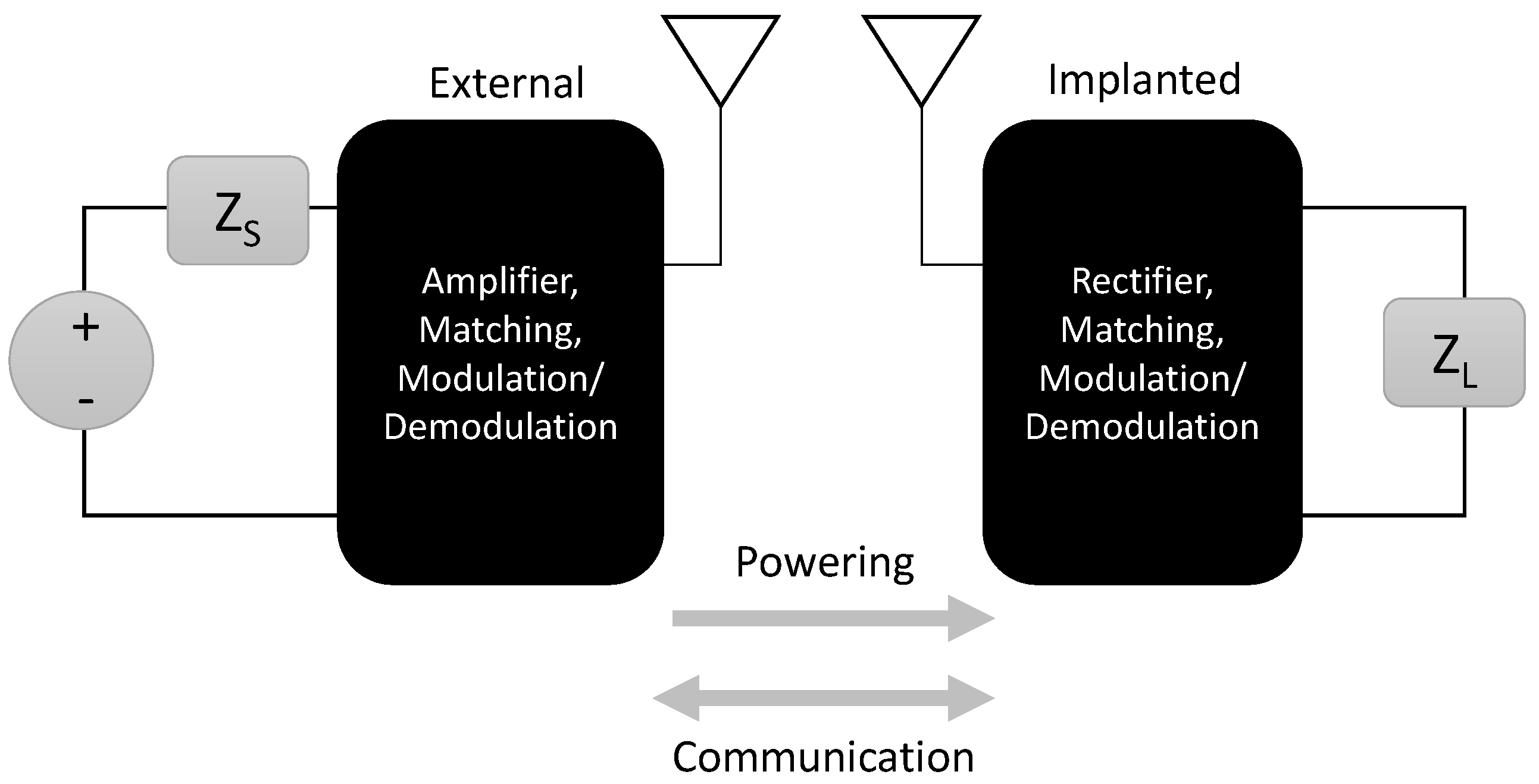
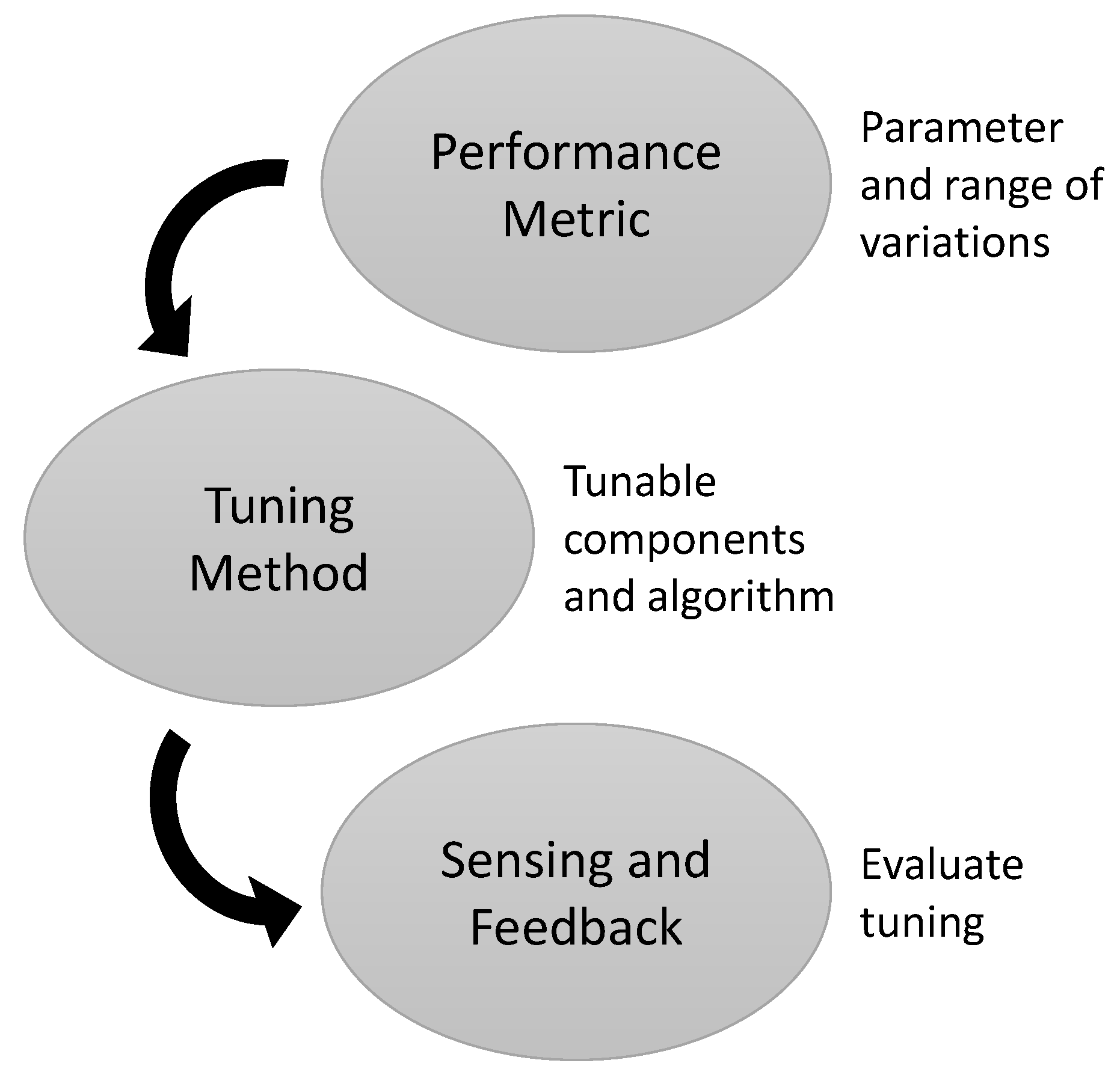
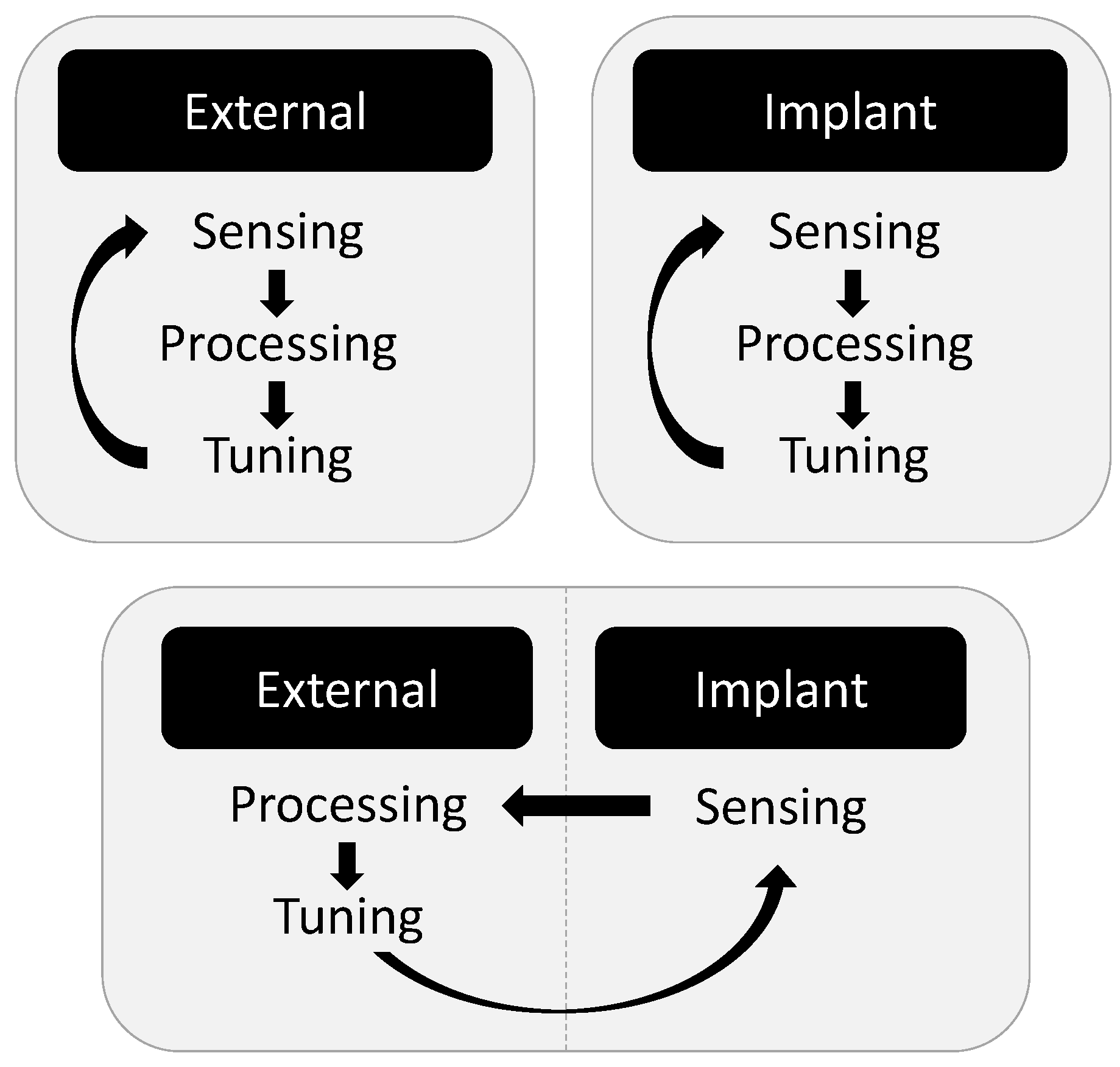
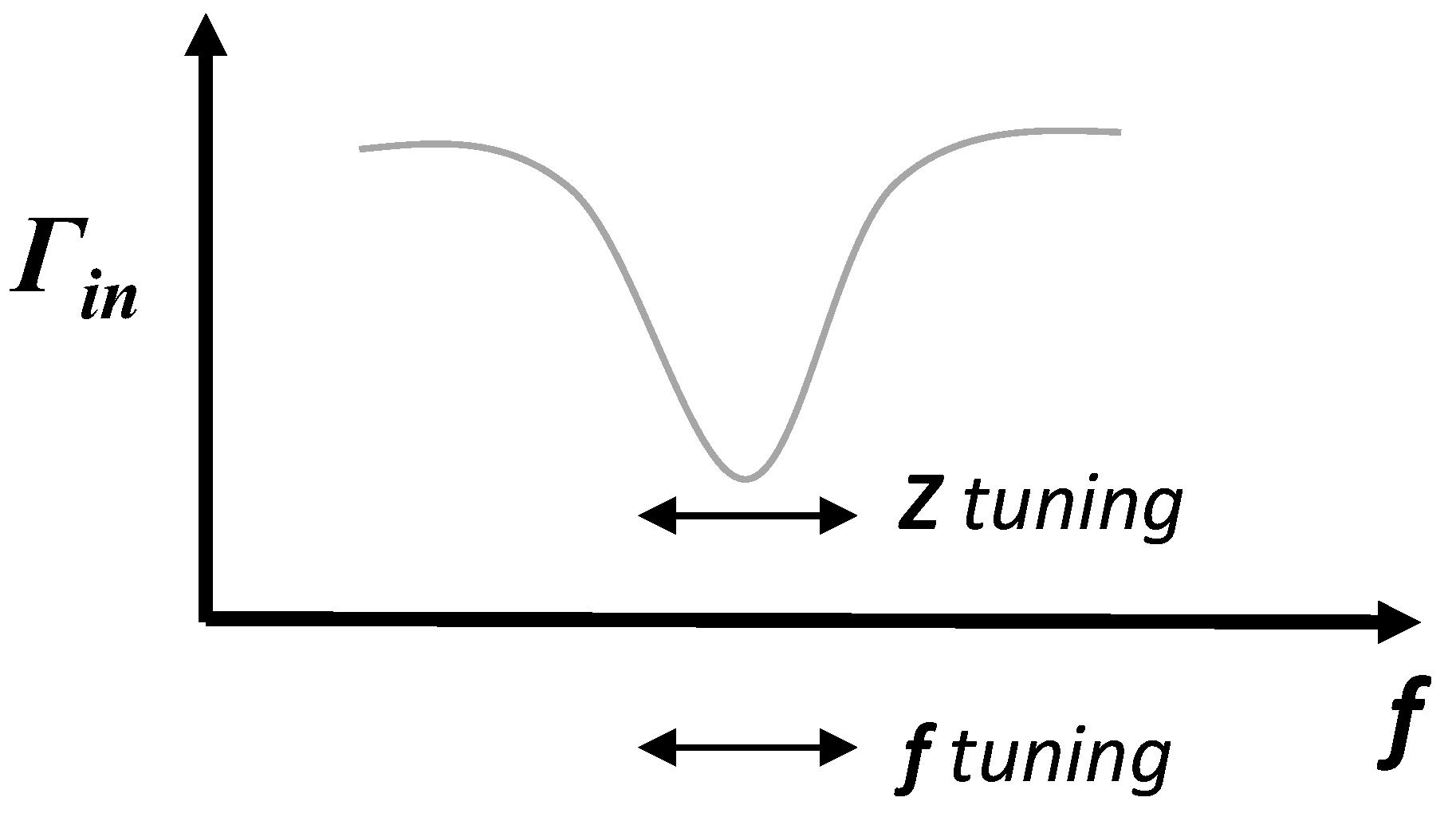
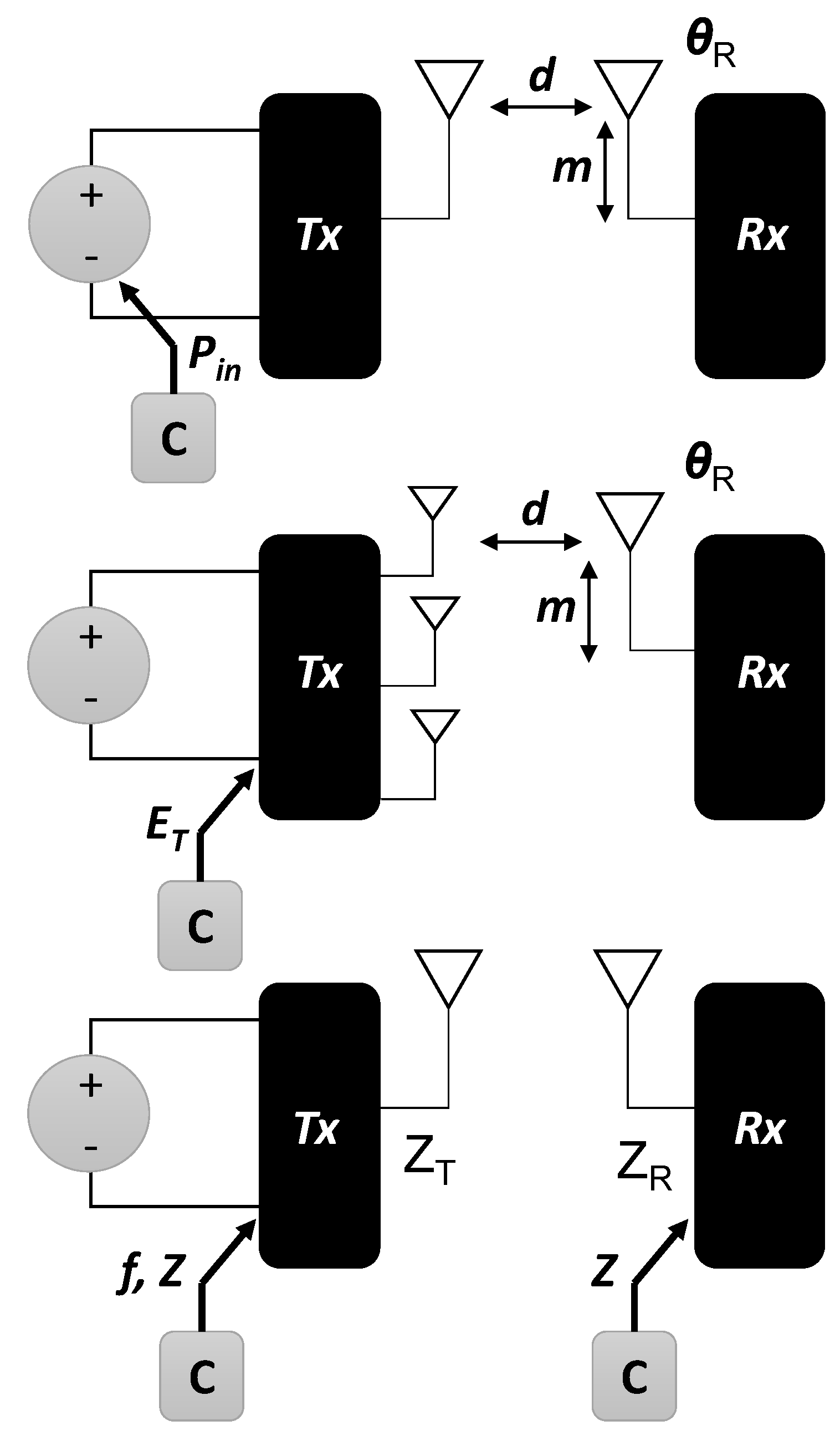
| Goal | Tuning | Feedback | Variation | |||
|---|---|---|---|---|---|---|
| Tx | Rx | Tx | Rx | |||
| [77] | Min reflections | Frequency (VCO) | Reflected voltage | Resonant frequency | ||
| [78] | Max efficiency | Frequency (VCO) | Antenna voltage | Resonant frequency | ||
| [40] | Max received voltage | Frequency (VCO), Power (supply voltage) | Rectified voltage | Resonant frequency, coupling | ||
| Max driver efficiency | Amplifier (transductor) | Phase between LC and coil driver voltage | Impedance due to frequency change | |||
| [82] | Resonance | Impedance (varactor) | Reflected voltage phase change | Distance and impedance | ||
| [83] | Resonance | Impedance (duty-cycled C) | Frequency | Impedance | ||
| [39] | Stable received power | Power (supply voltage) | Rectified voltage | |||
| [13] | Stable received power | Impedance (duty-cycled C) | Rectified voltage | |||
| [36] | Stable received power | Power (supply voltage) | Storage capacitor voltage | Movement and load impedance | ||
| [73] | Max efficiency | Frequency | Resonator voltage | Coupling, impedance | ||
| [80] | PA optimal load | Matching impedance (simulated) | Antenna impedance | Impedance | ||
| [31,89,93] | Match to PA or LNA | Matching impedance (varactor, switched C bank) | Antenna impedance | Impedance | ||
| Matching impedance (varactor) | Antenna impedance | Impedance | ||||
| [14,41] | Max power transfer efficiency | Power (supply voltage) | Rectified voltage | Position, fibrous tissue growth | ||
| Impedance | Rectified voltage | |||||
| [64,71,81,90] | Max power transfer efficiency | Matching impedance (switched C bank) | Rectified voltage | Position, impedance | ||
| Matching impedance (switched C bank) | Rectified voltage | |||||
| [37] | Stable received power | Power (supply voltage) | Rectified voltage | Distance, alignment | ||
| [79] | Max received voltage | Impedance (switched C bank) | Rectified voltage | Position | ||
| Stable received power | Power (supply voltage) | Rectified voltage | Position | |||
| [72] | Max efficiency (optimum load) | Impedance (switched C bank) | Rectified voltage gradient | Load impedance | ||
| [34] | Stable received power | Frequency (ZVS) | Switch transistor drain voltage | Coupling, load impedance | ||
| [15] | Max efficiency (relative to absorption) | Field pattern (antenna feeds) | Rectified voltage | Position | ||
| [92] | Max power transfer | Impedance (switched CLC pi bank) | Antenna port voltage | Impedance | ||
| [43] | Max power transfer | Frequency (ZVS) | Resonant tank voltage | Coupling | ||
| [84] | Max efficiency | Impedance (variable C) | S-parameters | Coupling | ||
| [23] | Max power transfer | Matching impedance (variable C) | S-parameters | Coupling | ||
| Max efficiency | Power | Reflected voltage | Coupling | |||
| [12] | Stable power, max efficiency | Power, resonant frequency | Received power | Coupling | ||
| [94] | Resonance | Impedance (switched C) | Output voltage, tuning capacitor voltage | Resonant frequency | ||
© 2016 by the authors; licensee MDPI, Basel, Switzerland. This article is an open access article distributed under the terms and conditions of the Creative Commons by Attribution (CC-BY) license (http://creativecommons.org/licenses/by/4.0/).
Share and Cite
Bocan, K.N.; Sejdić, E. Adaptive Transcutaneous Power Transfer to Implantable Devices: A State of the Art Review. Sensors 2016, 16, 393. https://doi.org/10.3390/s16030393
Bocan KN, Sejdić E. Adaptive Transcutaneous Power Transfer to Implantable Devices: A State of the Art Review. Sensors. 2016; 16(3):393. https://doi.org/10.3390/s16030393
Chicago/Turabian StyleBocan, Kara N., and Ervin Sejdić. 2016. "Adaptive Transcutaneous Power Transfer to Implantable Devices: A State of the Art Review" Sensors 16, no. 3: 393. https://doi.org/10.3390/s16030393
APA StyleBocan, K. N., & Sejdić, E. (2016). Adaptive Transcutaneous Power Transfer to Implantable Devices: A State of the Art Review. Sensors, 16(3), 393. https://doi.org/10.3390/s16030393





